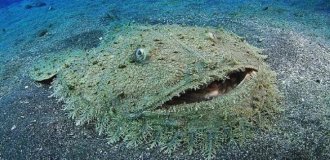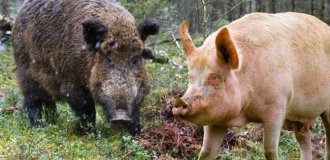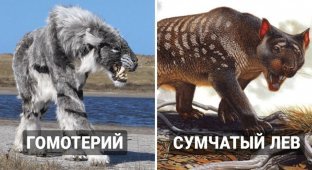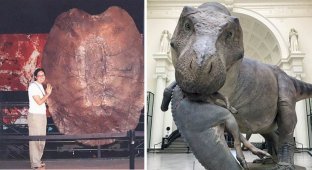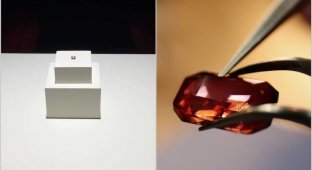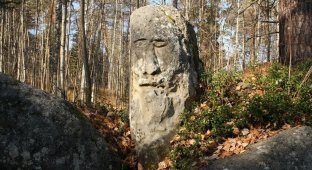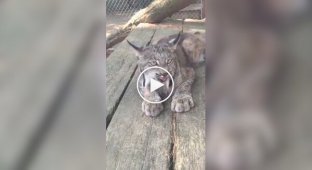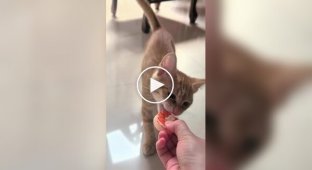Homotherium: Yakut lion in permafrost (14 photos)
At the end of November 2024, paleontologists finished describing the one-of-a-kind mummy of a Homotherium kitten. The baby was discovered in the Yakut permafrost, where it had lain for about 35 thousand years! 
Have you never heard of these big cats? Well, that's sad. After all, at the dawn of the human era, they were the ones who claimed the title of masters of the planet! 
Millions of years ago, Homotherium laid claim to more than half of the globe. Their remains have been found in North America, Siberia, Europe, and Africa. They even invaded South America, although they did not last long there. And throughout their entire range, they competed for ecological niches with two other major players: lions (common, cave, and American) and Smilodon, the saber-toothed tiger. 
Smilodons looked something like this. And I won't show you the lion, you already know him very well.
Each of the contenders for the title of the coolest cat on the planet has bet on a certain specialization. Smilodons turned into powerful ambush predators that kept the forests in fear. With their powerful fangs, they could bring down prey several times larger than themselves! Lions became the ultimate pack hunters, with whom even the ancient terrible wolves - XXL canines - could not compete. Homotheriums, however, took a different path: they decided to take advantage of the best features of their competitors! 
How beautiful it is in South America. Let me hug you!
Homotheriums borrowed their lifestyle from lions. Like the kings of modern savannas, they saw better in the light than most other cats and formed prides. Ancient predators chose savannas, steppes and prairies, where they developed tactics for group hunting of especially large herbivores. Yes, homotheriums were smaller than lions - their maximum weight did not exceed 200 kilograms. But they could put up a worthy resistance to their main competitors. 
Homotherium is weaker than a lion and a tiger, but did not perform in the circus. Because there was no circus in the Pleistocene((.
And all thanks to the weapon they borrowed from saber-toothed tigers - huge fangs! The teeth of the Homotherium were not as long as those of the Smilodons, but they became wider and stronger. This allowed the cats to hunt prey that was too big even for other predators. For example, young mammoths! 
Sanya, hold him, he's going to call his ex!
But their borrowings did not stop there. The Homotherium reached out with its raking paws even to the hyenas and stole them... the entire back half of the body! Our heroes had a wide, powerful pelvis, relatively short hind legs and a very small tail. 
Are you completely blind? I'm not a slouched dog. I'm a slouched cat!
These features not only gave them a slightly "hyena-like" appearance, but also turned them into more resilient animals. And coupled with developed lungs, cats turned into the most resilient felines on the planet. Apparently, packs of homotheres pursued small mammoths until they were exhausted. Wolves use the same tactics when they drive elk and deer to the point of complete loss of fighting ability! 
How good I am, how powerful my paws are!
Seriously speaking, of course, cats did not steal anything from anyone. Such a strange set of features is explained by an unusual origin: homotheres are a sister group to all modern cats! They separated from the general evolutionary tree more than 20 million years ago and therefore combined both ancient and modern feline features. 
An elongated muzzle with a large jaw is one of the primitive features of Homotherium. Such muzzles were in fashion among predators in the Oligocene, 20-30 million years ago.
And if earlier scientists could only guess about the difference between ancient and modern cats, then the find from Yakutia put everything in its place. Thanks to the tiny mummy, scientists were able to reconstruct the appearance of the kitten. It turned out that already at the age of three weeks, he demonstrated the distinctive features of his genus. 
The baby from Yakutia could not leave paleoartists indifferent! After just a couple of months, many arts with the kitten appeared. 
And here is the mother with the baby. It was not possible to determine why the kitten died. But it became a valuable find for scientists.
Paleontologists compared the mummy of Homotherium with a lion cub from the collection of the Zoological Museum of the same age. It turned out that the body of the baby from the permafrost was 10% shorter. But the neck, on the contrary, was longer and almost twice as thick. The paws were also almost twice as wide. They allowed the small Homotherium to move effortlessly through snowdrifts, as if on skis. 
The difference is visible to the naked eye. Above is a Homotherium kitten. Its muzzle is blunter and its forehead is wider. Below is a modern lion cub. 
Above is the Homotherium paw. Below is the paw of a lion cub.
Unfortunately, the unusual evolutionary history did not save the seals from extinction. And their unique specialization even accelerated it. When the last ice age coincided with the settlement of modern people, the Homotherium became very ill. Deterioration of living conditions and competition with people for resources quickly brought them to extinction. As well as their second competitors - Smilodons. 
Bone figurine from the Isturitz cave, France. Late Paleolithic. It is assumed that this was an attempt to capture the Homotherium.
But the lions, as you know, survived. They can be considered the winners in this competition. Only instead of power over the planet, they received only small pieces of Africa.
